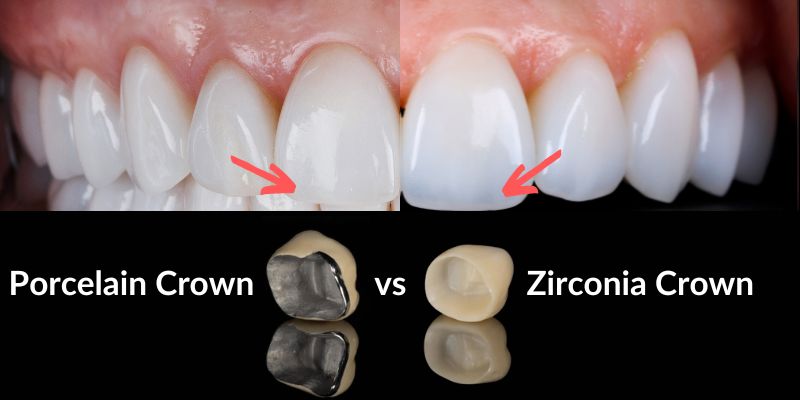Zirconium Crowns vs Porcelain, Which is the Better Option?

When it comes to dental restorations, crowns play a pivotal role in not only strengthening damaged teeth but also enhancing the aesthetics of one's smile. Crowns are often a necessary treatment for those who suffer from extensive decay, structural damage, or for cosmetic purposes. Two of the most commonly recommended materials for crowns are porcelain and zirconia. In this article, we will delve into the key differences, benefits, and considerations between these two popular types of dental crowns.
The Importance of Dental Crowns
There is no denying the significant advancements in modern dentistry, allowing many people to achieve the smiles they've always wanted. For individuals dealing with extensive tooth decay or damage, dental crowns provide a solution that restores both function and appearance. The benefits of such treatments extend beyond mere aesthetics—numerous studies have shown that oral health is closely linked to self-esteem and overall well-being.
One study highlighted by Forbes revealed that 1 in 5 adults reported a decrease in social activities due to poor oral health, with many stating that the condition of their teeth even discouraged them from attending job interviews. This shows the far-reaching impact dental issues can have on one's personal and professional life.
Porcelain Crowns: A Classic Choice
Porcelain crowns, also known as porcelain-fused-to-metal (PFM) crowns, have been widely used in dentistry for several decades. These crowns are made by fusing a layer of porcelain over a metal core, typically composed of gold or another metal alloy. This construction provides both strength and a natural tooth-like appearance.
Advantages of Porcelain Bonded Crowns:
- Aesthetic Appeal: Porcelain bonded crowns can closely mimic the translucency and colour of natural teeth, making them an excellent choice for front teeth restorations.
- Strength and Durability: The metal core provides additional strength, enabling these crowns to withstand the forces of chewing and biting.
- Precision Fit: These crowns are custom-made to ensure a precise fit over the tooth, providing comfort and stability.
- Affordability: Compared to some other materials, porcelain bonded crowns can be a more cost-effective option for patients seeking a durable and aesthetically pleasing restoration.
Zirconia Crowns: The Modern Alternative
In recent years, zirconia crowns have emerged as a revolutionary option in restorative dentistry. Made from zirconium dioxide, a highly durable and biocompatible material, these crowns have quickly gained popularity due to their exceptional strength and aesthetic properties.
Advantages of Zirconia Crowns:
- Superior Strength: Zirconia crowns are significantly stronger than porcelain bonded crowns, making them ideal for both front and back teeth. Their resistance to chipping, cracking, and wear means they can last for many years without issue.
- Aesthetics: Zirconia crowns are highly translucent and closely mimic the appearance of natural teeth. This makes them an excellent choice for patients who prioritise aesthetics, especially for visible teeth.
- Biocompatibility: Zirconia is well-tolerated by the human body, reducing the risk of allergic reactions and gum irritation that can sometimes occur with metal-based crowns.
- Minimal Tooth Reduction: Unlike porcelain crowns that may require significant tooth reduction, zirconia crowns often require less removal of natural tooth structure, helping preserve the integrity of the tooth.
Porcelain vs Zirconia: Key Differences
While both porcelain bonded and zirconia crowns serve a similar purpose, they differ significantly in terms of material properties, longevity, and application. Porcelain crowns are created by layering porcelain over a metal core, which can sometimes cause discolouration near the gum line over time. Moreover, metal allergies can be an issue for some patients.
On the other hand, zirconia crowns are made entirely from a non-metallic, white material, which eliminates the risk of metal-related issues. Their durability is unparalleled, and their smooth surface reduces the risk of wearing down adjacent teeth, a common problem with other materials.
In terms of aesthetics, both options are highly regarded, but zirconia's natural translucency offers a more seamless integration with the surrounding teeth.
Which Crown Material is Right for You?
Choosing the right type of dental crown ultimately depends on several factors:
- Location of the Tooth: Front teeth often benefit from the aesthetic properties of porcelain, while the strength of zirconia may be more suitable for back teeth.
- Bite Force: If you have a strong bite or tend to grind your teeth, zirconia may be the better choice due to its strength and durability.
- Aesthetic Preferences: While both materials can offer excellent aesthetic results, zirconia's translucent, natural appearance makes it an attractive option for patients prioritising aesthetics.
- Budget: Porcelain bonded crowns are generally more affordable than zirconia crowns, so cost may also play a role in the decision-making process.
Conclusion
Both porcelain bonded crowns and zirconia crowns offer distinct advantages, and the choice between the two depends on individual patient needs, preferences, and budget. Porcelain crowns are cost-effective and aesthetically pleasing but may lack the long-term durability of zirconia. Conversely, zirconia crowns offer superior strength and biocompatibility, making them ideal for patients looking for a long-lasting, highly aesthetic solution.
Consulting with your dentist to thoroughly evaluate your specific dental situation is essential for determining the best crown material for your restoration needs. At the end of the day, whether you opt for porcelain or zirconia, you can be confident that both options will enhance your smile and improve your oral health.
For more personalised advice and to explore the best treatment options for you, feel free to get in touch with our clinic.
 English
English
